How Konev's armies liberated Kirovograd
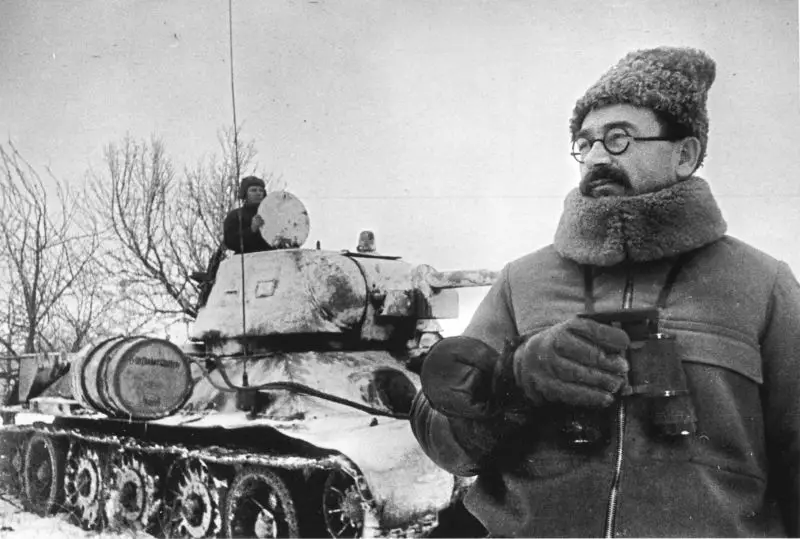
Colonel-General tank troops Pavel Alekseevich Rotmistrov, commander of the 5th Guards Tank Army, at the T-34 tank during the Kirovograd offensive operation
General situation
In the summer - autumn of 1943, Soviet troops occupied the entire Left Bank Ukraine and during the battle for the Dnieper (Give me the Dnieper! 80 years ago the battle for the Dnieper ended) captured strategic bridgeheads on the right bank of the Dnieper, which created favorable conditions for the subsequent offensive in Right Bank Ukraine.
The strategic plan of the Soviet Headquarters for the winter campaign of 1944 was to defeat the enemy in the northwestern and southwestern directions with a series of successive strikes. That is, an offensive was envisaged from the Baltic to the Black Sea with the goal of defeating Army Group North, Army Groups South and A, and Wehrmacht flank strategic groupings in the Leningrad region, on the Right Bank of the Dnieper and in the Crimea.
The main attacks were carried out in the southwestern strategic direction with the goal of liberating Right Bank Ukraine and Crimea. On December 24, 1943, the Dnieper-Carpathian strategic operation or the Battle for Right Bank Ukraine began (The battle for the liberation of Right Bank Ukraine).
The operation was carried out by the 1st, 2nd, 3rd and 4th Ukrainian Fronts, which had 2,3 million people, 28,8 thousand guns and mortars, over 2 thousand tanks and self-propelled guns, more than 2,3 thousand. airplanes. Soviet troops had superiority in strength.
On the Right Bank there were two German army groups - “South” and “A”, which included 1,7 million soldiers, 16,8 thousand guns and mortars, 2,2 thousand tanks and self-propelled guns, 1460 aircraft.
The German command hoped that after the fierce battle for the Dnieper, in which both sides suffered heavy losses, the Russians would not be able to immediately develop an offensive on the Right Bank.
The first blow was delivered on December 23, 1943 by the 1st Ukrainian Front under the command of Vatutin. In stubborn battles, Russian troops broke through enemy defenses up to 300 km wide and 100 km deep. The cruel enemy was finally driven back from the ancient Russian capital and the capital of the Ukrainian SSR - Kyiv. Korosten, Brusilov, Kazatin, Zhitomir, Berdichev and Bila Tserkva were liberated (Fierce battle for Zhitomir and Berdichev). The Red Army created a threat to the left flank of the Korsun-Shevchenko group of the Wehrmacht.

To Kirovograd
In the fall of 1943, the 2nd Ukrainian Front (2nd UV), under the command of Ivan Konev, during the Battle of the Dnieper, expanded the bridgehead captured on the right bank of the Dnieper in the area from Kremenchug to Dnepropetrovsk. Having pushed the enemy 30-100 km from the river and liberated Cherkassy, Znamenka and Alexandria, by December 20, Soviet troops reached the approaches to Kirovograd and Krivoy Rog.
On December 29, 1943, the Soviet Headquarters set the next tasks for the 2nd UV: on January 5, resume the offensive, delivering the main blow to Kirovograd in order to defeat the Kirovograd enemy group and occupy Kirovograd, covering it from the north and south. In the future, capture the Novo-Ukrainka, Pomoshnaya area and advance on Pervomaisk with the aim of reaching the river. Southern Bug, where to gain a foothold. The front launched an auxiliary attack on Ivangorod, Zlatopol, Balakleya, Shpola and further on Khristinovka.
The front command included in the main strike group the 53rd, 5th and 7th Guards, 5th Guards Tank Armies of generals Galanin, Zhadov, Shumilov and Rotmistrov, as well as the 5th Guards and 7th Mechanized Corps of Skvortsov and Katkov. In the auxiliary direction (right flank) the 4th Guards and 52nd armies of Ryzhov and Koroteev were advancing. The offensive was supported from the air by Goryunov's 5th Air Army.
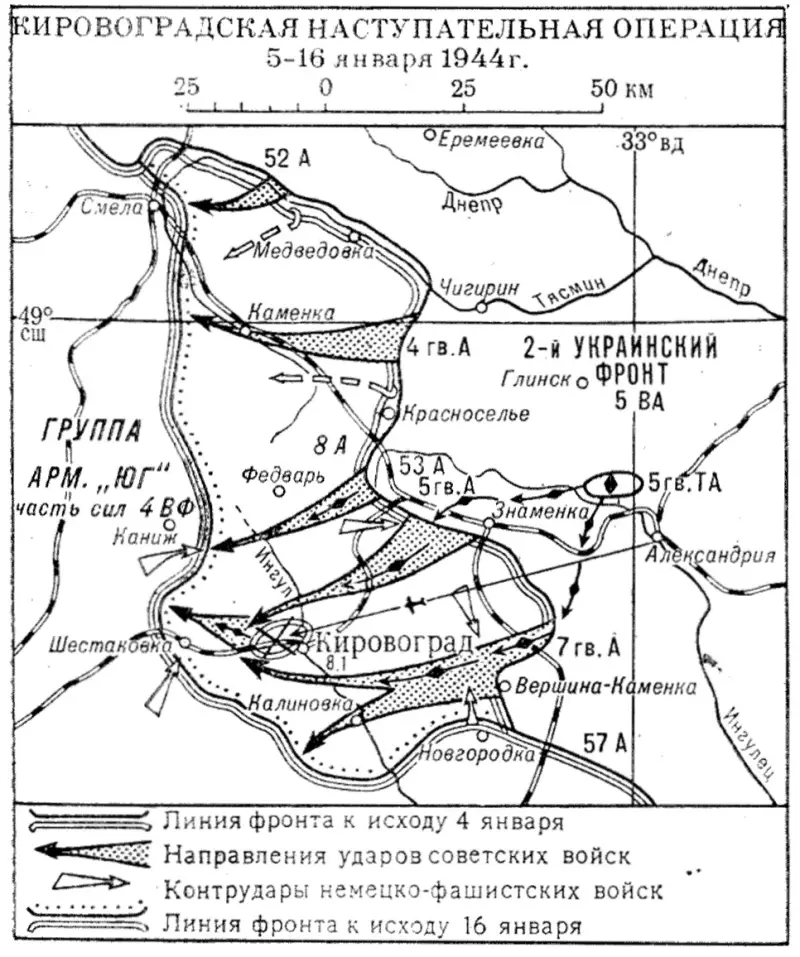
The forces of the parties
In total, the armies of the 2nd UV on January 1, 1944 numbered 550 thousand people, over 380 tanks and self-propelled guns, more than 7,1 thousand guns and mortars (not counting anti-aircraft guns), 500 aircraft.
In the Kirovograd direction, the troops of the German 8th Army of General Otto Wöhler - the 11th, 47th and 52nd Army Corps - defended. The 4th Air Fleet provided air support.
The Nazis, having lost the strong defensive Dnieper line, did not yet have time to prepare a deep layered defense. As Konev recalled (I. S. Konev, Notes of the Front Commander):
The German defense was based on a system of strong points. Wire and mine barriers were widely used. The second line of defense, located 6-8 km from the front line, was weaker than the front line. Kirovograd itself was turned into a “fortress”. At the same time, the Germans had several mobile divisions, with the help of which they could launch counterattacks from the depths of the defense. The 2th motorized, 10rd, 3th, 11th and 13th tank divisions operated in front of the center of the 14nd UV. During the operation, the enemy pulled up and brought into battle the SS tank division “Totenkopf”.
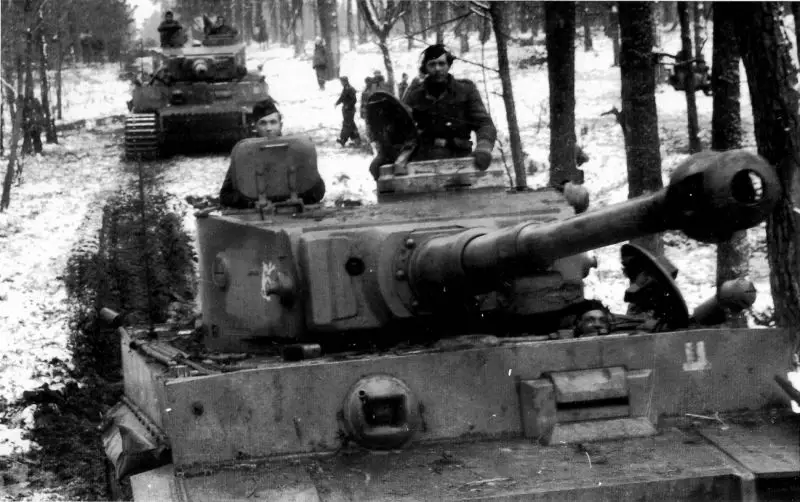
Tigers of the 2nd SS Division "Das Reich" on the march in the forest near Kirovograd. December 1943
As Konev noted:
In the direction of the main attack (80 km), the command of the 2nd UV concentrated large forces, creating an overwhelming superiority over the enemy: 30 rifle divisions out of 56 (in addition, 3 more divisions were in the front reserve), 5 mechanized and tank corps (not counting 2 corps that were in the front reserve for restoration). Also, 100% of the armored forces and about 60% of the artillery were assembled here.
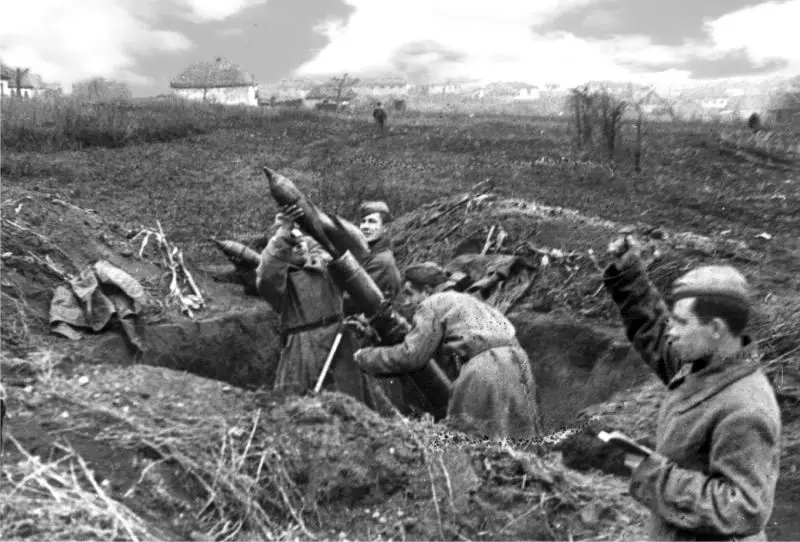
A mortar crew of Guard Sergeant Major S. Lisin fires at the enemy in the Kirovograd region. December 1943
Offensive. Defense Breakthrough
On the morning of January 5, 1944, after a 50-minute artillery preparation, the front’s strike force began its offensive. The enemy's defense could not withstand the powerful concentrated attack. Troops of the 5th Guards and 53rd armies broke through the enemy's defenses and fought to repel German counterattacks. To develop the offensive in the breakthrough areas, the 7th and 5th Guards Mechanized Corps were brought into battle. By the end of the first day of the operation, there was success on the right flank of the front's strike group. The tactical zone of German defense was overcome in certain directions, and the troops advanced to a depth of 4 to 24 km.
Shumilov's guards, advancing on the left flank of the strike force, were unable to break through the enemy's defenses on the move. Our troops held back strong enemy counterattacks from the Adjamka and Novaya Andreevka areas. Therefore, Rotmistrov’s tank army had to be brought into battle not into the gap created, but in order to complete the breakthrough of the enemy’s defense. This slowed the initial rate of advance of the 5th Guards Tank Army.
The front command decided to use the success that was emerging in the sector of Zhadov’s 5th Guards Army. The 5th mechanized corps of General Khasin from Rotmitrov’s army was transferred to this direction. The 7th and 8th mechanized corps were to develop an offensive bypassing Kirovograd from the north-west with the aim of cutting off the routes leading from the city to the west and north-west, and in cooperation with the troops of the 5th Guards Tank Army to capture Kirovograd.
On January 6, 1944, the Soviet armies developed an offensive. The Germans tried to stop the attack of the 2nd UV on Kirovograd and regrouped their forces on the northern flank. Particularly strong counterattacks of the Nazis were carried out on the front of the 5th Guards and 53rd armies.
However, by the end of the second day of the operation, units of the 5th and 7th Guards armies, overcoming stubborn enemy resistance, connected their flanks, expanding the breakthrough to 70 km along the front and to 30 km in depth. The 53rd Army, operating together with the 5th Guards Mechanized Corps, repelling enemy counterattacks, also moved forward and covered the right flank of the front’s strike force.
In the zone of the 7th Guards Army, German resistance also increased, and the 24th Guards Rifle Corps (the second echelon of the army) was brought into the battle. He received the task of attacking in the southern and southwestern directions in order to support the advancing strike force of the army on the left.
Liberation of Kirovograd
Rotmistrov's tanks, having immediately overcome the second line of enemy defense on the Adzhamka River, reached the Kirovograd area. On the night of January 7, the 29th Tank Corps near Kirichenko reached the southeastern part of the city, the 18th Tank Corps captured Fedorovka and moved to Novo-Pavlovka. Following the tankers, the 50th and 297th rifle divisions of Lebedenko and Kovtun-Stankevich of the 7th Guards Army, as well as the 9th Guards Airborne Division of the 5th Guards Army, reached Kirovograd. Fighting for the city began.
By the morning of January 7, the mobile units of the front reached the Lelekovka crossing, intercepting the Kirovograd-Novo-Ukrainka highway and railway. At the same time, units of the 18th Tank Corps blocked the Kirovograd-Rovnoe road in the Novo-Pavlovka area. As a result, all escape routes for Nazi troops operating in the Kirovograd area and east of it were closed. However, it was not possible to create a dense encirclement ring, and the Germans from the Kirovograd region successfully retreated to the west.
All day on January 7, Russian troops repelled continuous counterattacks of the enemy, who tried to stop the Soviet offensive. By the morning of January 8, 1944, Kirovograd was cleared of the Nazis. In honor of this event, the troops who participated in the liberation of Kirovograd were thanked by order of the Supreme Commander-in-Chief I. Stalin dated January 8, 1944, and a salute was given in Moscow with 20 artillery salvoes from 224 guns.
Stubborn fighting continued until mid-January. Enemy resistance intensified. The German command transferred reinforcements. The 2nd UV advanced on the main direction to the west by another 15-20 km. In the auxiliary direction, the 4th Guards and 52nd armies, which had covered up to 10 km by January 40, were stopped by strong counterattacks of the Germans, who deployed additional forces against them (up to three tank divisions).
On January 16, the front troops went on the defensive. During the operation, the front troops covered 40-50 km and secured a position on the line east of Smela - west of Kirovograd - north of Novgorod. The Nazis were expelled from Kirovograd. A threat was created to the right flank of the Korsun-Shevchenko group of the Wehrmacht. The German command had to transfer troops here from other sectors, facilitating the offensive of the 1st and 3rd Ukrainian fronts.
Generals Vatutin and Konev began preparing an operation to encircle and destroy the Korsun-Shevchenko enemy group.
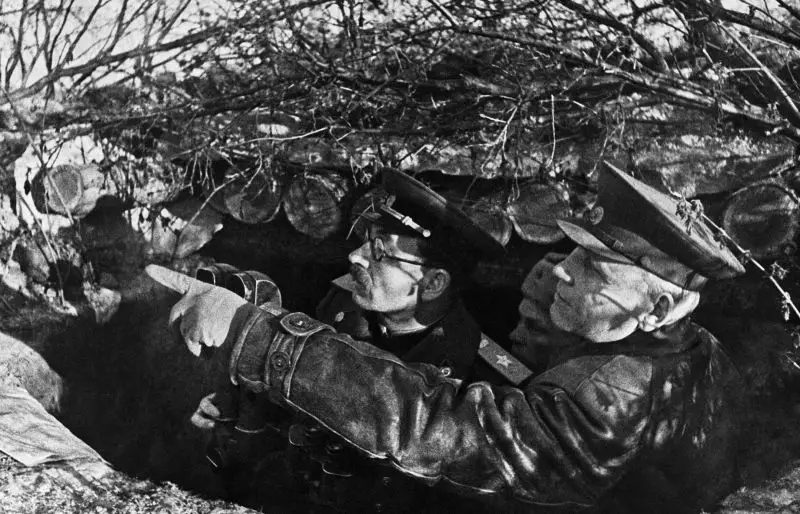
The commander of the 2nd Ukrainian Front, Marshal I. S. Konev and the commander of the 5th Guards Tank Army P. A. Rotmistrov at the observation post. 1944
Information